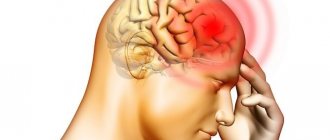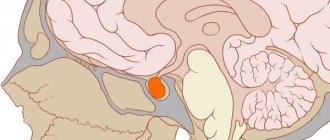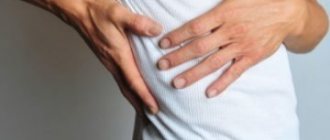Intercostal neurosis or intercostal neuralgia is a common disease that occurs in people of any age and gender. Its name accurately reflects its essence - pinched nerve roots cause pain localized in the area of the ribs . But why such a disease occurs, how it differs from others and how to treat it are questions whose answers remain to be found by examining the disease in more detail.
Intercostal neurosis can begin in people of any age
Causes
In most cases, a pinched nerve is associated with muscle spasm or inflammation, which can occur for a variety of reasons. Let's look at the most common of them:
- Spinal injuries or chest injuries.
- Osteochondrosis.
- Some infectious diseases.
- Drafts.
- Lifting weights.
- Working in an awkward position.
- Sudden sharp movements.
- Severe hypothermia.
- Excessive physical activity.
- Prolonged stressful situations.
- Metabolic disease.
- Lack of vitamin B in the body.
- Diabetes.
Prevention
Taking preventive measures can reduce the risk of intercostal neuralgia, as well as speed up treatment if it has already appeared. Therefore, it is worth paying attention to the basic rules of prevention and special gymnastics.
Simple recommendations help reduce the risk of neuralgia, fight it if a person is already sick, and also improve the general condition of the body, allowing you to avoid many different diseases.
Just follow the rules:
- Treat your spine in a timely manner;
- Improve your immunity, take care of your health;
- Try not to get too cold;
- Allow sufficient time for breaks during work;
- Eat right, give up bad habits.
Such rules are especially important for people of retirement age, as well as those who suffer from chronic diseases associated with the spine.
Special gymnastics shows high effectiveness against thoracic neuralgia. In most cases, it is able to affect even the underlying cause, which makes it very important for general therapy. Therefore, it is recommended to pay special attention to it.
- Lie on your back, begin to pull your legs one by one towards your chest, bending your knees. Additionally, you should try to reach your knees with your forehead.
- Roll over onto your stomach with your arms stretched forward. Raise your upper body upward, bending your back.
- Sit on a chair, clasp your hands behind your head, lean forward. After this, stand up and additionally bend or turn 90° with your entire torso.
- Lying on your back, stretch your legs and bend your arms at the elbows perpendicular to the floor. Tightening your chest muscles, slowly move your arms up and down.
- Stand up straight, spread your arms straight to your sides. Using the abdominal and chest muscles, rotate both sides of the body in the shoulder area.
Such exercises can only be performed when you feel normal, because... during an exacerbation, they will not provide any help and will harm the body.
Intercostal neuralgia is not a very dangerous disease, but it causes severe pain. Therefore, it is better to prevent pinched nerves, since treatment of the pathology will be long and complex.
For prevention, you need to follow some rules:
- eat right, ensure that the body receives all the necessary nutrients;
- stop using alcohol and drugs;
- avoid drafts and hypothermia;
- do not expose your back to heavy physical activity, alternate work and rest correctly;
- watch your posture;
- avoid injury;
- timely treat infectious diseases and pathologies of the musculoskeletal system.
Timely treatment of intercostal neuralgia will help avoid complications and the pathology becoming chronic. But it is very important to use any methods only after consulting a doctor and making an accurate diagnosis, so as not to mistake a more serious pathology of internal organs for a pinched nerve.
Symptoms of the disease
Symptoms of intercostal neurosis include the following conditions:
- Constant or intermittent pain in the rib area. May be aching, sharp or dull.
- Sudden movements may intensify the pain. For example, when coughing.
- Painful sensations may radiate to the shoulder blades or lower back.
- Increased sweating.
- Muscle twitching and redness or paleness of the skin of the affected area may occur.
- When you press on some areas of the thoracic region, painful sensations appear.
- A feeling of numbness may occur at the site of damage to the nerve fibers.
There are external signs of this pathological condition:
- The man is tense.
- With sudden movements, increased pain occurs.
Why does nerve pain occur in the chest?
Such muscle strain very often leads to pain in various areas of the human body. Including in the chest.
Vegetative-vascular dystonia is often associated with phenomena such as bloating and increased gas production. The gases accumulated in the intestines distend the abdominal cavity, it begins to prop up the lungs and heart from below, and this leads to chest pain.
The second reason why the abdomen is a source of discomfort in the chest area is referred pain.
This is one of the most common bodily problems that anxious neurotics encounter, because it is quite difficult to worry and not lose your breath.
The connection between hyperventilation and chest pain is as follows. Hyperventilation leads to contraction of blood vessels, and this, in turn, can cause pain, including in the chest, where the vessels are very large.
All anxious patients with manifestations of vegetative-vascular dystonia, that is, symptoms of physical anxiety, are focused on the state of their health and pay excessive attention to it.
However, some neurotics achieve aerobatics in these actions. And they feel pain when there is none at all. And especially often they feel it in the chest, because the heart is there, and it is not healthy for them, therefore, it must hurt.
The difference between pathology and heart disease
Despite the fact that the signs of intercostal neurosis and heart disease are very similar, there are some features that allow a more accurate diagnosis to be made. Let's take a closer look at them.
With intercostal neurosis, the pain is almost constant, it intensifies with sudden movements. This is due to pinched and irritated nerve endings.
The intensity of heart pain does not depend on the intensity of movements and uncomfortable body position. It goes away or is significantly weakened when taking nitroglycerin. In this case, changes in heart rate and blood pressure are observed.
Why does nerve pain occur in the chest?
Such muscle strain very often leads to pain in various areas of the human body. Including in the chest.
Vegetative-vascular dystonia is often associated with phenomena such as bloating and increased gas production. The gases accumulated in the intestines distend the abdominal cavity, it begins to prop up the lungs and heart from below, and this leads to chest pain.
The second reason why the abdomen is a source of discomfort in the chest area is referred pain.
This is one of the most common bodily problems that anxious neurotics encounter, because it is quite difficult to worry and not lose your breath.
The connection between hyperventilation and chest pain is as follows. Hyperventilation leads to contraction of blood vessels, and this, in turn, can cause pain, including in the chest, where the vessels are very large.
All anxious patients with manifestations of vegetative-vascular dystonia, that is, symptoms of physical anxiety, are focused on the state of their health and pay excessive attention to it.
However, some neurotics achieve aerobatics in these actions. And they feel pain when there is none at all. And especially often they feel it in the chest, because the heart is there, and it is not healthy for them, therefore, it must hurt.
Carrying out diagnostics
To determine or confirm the diagnosis, a set of diagnostic measures is carried out, which include laboratory and instrumental methods. These include:
- An appointment with a doctor, during which an anamnesis of the disease is collected, the time of onset of the first pain, its duration and intensity, the presence of injuries and lifestyle are specified.
- Neurological examination.
- Urine and blood analysis.
- An ECG, which will confirm or exclude the presence of heart disease.
- An X-ray used to examine a patient's lungs.
- Ultrasound examination of the heart.
Cervicothoracic osteochondrosis with VSD
In medicine, there is an opinion that cervicothoracic osteochondrosis and VSD can provoke each other. According to statistics, about 90% of cases of VSD are caused by osteochondrosis. The difference between these pathologies is the origin of the symptoms themselves: with VSD, the main cause is a disruption in the functioning of the autonomic nervous system, and with osteochondrosis, blood circulation is disrupted, as a result of which the pressure rises.
The symptoms of cervicothoracic osteochondrosis and VSD are almost the same, so the diagnosis should be made exclusively by a doctor. There are cases when these 2 pathologies accompany each other. Treatment of both diseases is carried out comprehensively: drugs are used to relieve inflammation in the cervical spine and exercises are performed to relieve tension. To eliminate inflammation, you can use ointments such as Diclofenac or Fastum-gel. It is recommended to completely quit smoking and alcoholic beverages.
etodavlenie.ru
Treatment methods
Once the diagnosis is confirmed, the treatment plan is prescribed by the attending physician individually in each case, depending on the provoking factor and the general condition of the patient. With intercostal neurosis, symptoms and treatment are interrelated, since eliminating the cause of the disease is of great importance. As a rule, a comprehensive approach to therapy is used, including drug treatment, physical therapy and, in particularly severe cases, surgery.
The conservative method involves taking the following categories of medications:
- Anti-inflammatory medications, which can be in the form of tablets, suppositories or injections.
- Painkillers, including blockades.
- Antispasmodics.
- Vasodilator medications that help improve blood circulation.
- Ascorbic acid injections.
- Anticonvulsants that help normalize muscle tone.
- Taking B vitamins, which strengthen nerve fibers.
- Sedatives.
With this disease, great importance is given to physiotherapy. These include:
- Electrophoresis with novocaine.
- Magnetotherapy.
- Amplipulse.
- UHF therapy.
- Thermal procedures.
- Ultraphonophoresis.
- Reflexology.
- Manual methods for osteochondrosis.
To relieve spasms, the following procedures can be used, which receive a lot of praise:
- Acupuncture.
- Hot stones.
- Hirudotherapy.
- Acupressure.
- Yoga classes.
Intercostal neurosis: causes, symptoms and treatment of muscle spasm during neuralgia
Intercostal neurosis is compression of the intercostal nerves caused by injuries, compression injuries, inflammation, which is accompanied by acute burning or shooting pain in the ribs. The disease occurs in people of all ages, but is most common in adults.
The structure of the intercostal nerves contains sensory, motor and sympathetic fibers. The intercostal nerves form 12 pairs. They provide innervation to the chest, mammary glands, pleura (costophrenic), anterior abdominal wall, and peritoneum.
The sensory fibers of neighboring nerves connect, and thus cross innervation occurs (one area of the skin or muscle is innervated by the main nerve, as well as neighboring ones).
Causes of neurosis
The pain appears due to the fact that the nerves located in the intercostal space are compressed (pinched). The reasons for the development of pathology may be:
- posture disorders;
- osteochondrosis of any part of the spine;
- flick;
- strong physical activity;
- prolonged stress;
- injuries;
- being in a draft;
- the presence of a focus of infection in the body.
More often, pathology appears due to sudden movement. In this case, a pinched nerve occurs. It’s easy to find yourself in such a situation - sit at the computer for a long time in one position, and then sharply turn your body.
Intercostal neurosis can happen to anyone. Often pain in this area appears due to exhaustion of the nervous system or stress. The danger lies in being in a draft, including in a room with the air conditioner on. Often in hot weather, people do not notice drafts, which provokes nerve irritation and pain.
Disease Prevention
Intercostal neurosis can be prevented by treating emerging problems, diseases of the spine and preventing its curvature, timely treatment of injuries in the chest area.
Increasing the level of immunity will help to avoid herpes infection, which provokes neuralgia.
This can be achieved through sports, adequate physical activity, hardening, and a healthy lifestyle.
As a preventive measure, you should also reduce the amount of stress, reduce alcohol consumption, and normalize the level of physical activity.
Symptoms of pathology
Intercostal neurosis is characterized by the following symptoms:
- sharp pain between the ribs on any side of the body;
- increased discomfort when coughing, sneezing, turning the body;
- voluntary muscle twitching;
- numbness in the area around the affected nerve.
Often such neuralgia causes pain in the lower back or thoracic spine. Pain may also be felt under the shoulder blade.
Usually the discomfort is paroxysmal in nature. The pain intensifies and then subsides. If you press on several points located in the thoracic region, the pain will intensify significantly.
Often when a nerve is pinched on the left, the symptoms are much like pain in the heart area. The patient begins to fear for his health, which results in stress and increased pain against this background.
Neuralgia in the right side of the ribs can be mistakenly confused with pathologies of the lungs, since pain is felt precisely in this area. Often intercostal neuralgia has the character of “lumbago”, that is, the pain seems to penetrate the entire human body through and through, especially with sudden movement.
Externally, neuralgia is noticeable to the naked eye - the patient is tense, tries to limit the amplitude of his own movements, and if necessary, turn around, he slowly turns around with his whole body.
Such external features have one goal - to avoid accidentally making a sudden movement, which causes multiple increases in pain.
Which doctor treats intercostal neurosis?
At the first appointment, specialists will examine the patient. They will be able to immediately determine that the problem is not related to cardiovascular disease. The doctor will listen carefully to the patient’s complaints and also ask him several clarifying questions:
- How long ago did the first symptoms of intercostal neurosis appear? What is the nature of the pain?
- Have there been similar problems in the past?
- Has the person been hypothermic recently?
- Did you have problems with your spine?
- Does the person suffer from chronic diseases?
- Did he try to cope with the disease on his own?
The information received from the patient will help the specialist determine exactly what caused the intercostal neurosis. The data will also be used to develop a treatment program. It is always compiled by a doctor for the patient on an individual basis. In this case, attention is paid to the physiological characteristics of the patient, his general health and age are taken into account.
Regardless of the reasons that caused the spasm and the characteristics of the accompanying pathologies, drug treatment is used for intercostal neuralgia. Drugs are prescribed to relieve general symptoms and improve the patient’s quality of life.
physiotherapy
massage
In addition to treating intercostal neuralgia with medications, other methods are used, including massage, physical therapy and surgery. The choice of tactics depends on the disease that led to the syndrome. Therefore, before starting treatment, diagnostics are carried out using CT, MRI and other methods.
Therapy for intercostal neuralgia is often carried out at home. Treatment in a hospital is prescribed in the presence of severe complications. To relieve pain, ointments, tablets or injections of non-steroidal anti-inflammatory drugs are used for intercostal neuralgia. For muscle tension, taking muscle relaxants is indicated.
When selecting medications, it is important to take into account the individual characteristics of the patient and the nature of the concomitant pathology. If pain is associated with the gastrointestinal tract, it is not recommended to take medications in tablet form. Such medications irritate the gastric mucosa, thereby increasing the intensity of general symptoms.
In the acute period, when the pain syndrome manifests itself most intensely, bed rest is recommended. Dry heat (heated sand in a cloth bag) must be applied to the sore spot. It is important not to overheat the problem area. Otherwise, as the skin cools, the intensity of the syndrome will increase.
This disease is certainly unpleasant and painful, but still not terrible.
- In order to reduce pain, painkillers are prescribed, such as Diclofenac, Nise, Nimesulide, Ibuprofen, Ketarol. And if this does not help, an intercostal anesthetic block is performed.
- Relieving muscle spasm. Muscle relaxants and anticonvulsants are prescribed.
- Taking anti-inflammatory drugs.
- Strengthening the nervous system, including taking B vitamins that improve the nutrition of nerve fibers and glycine. Sedatives that calm the nerves.
- Physiotherapy, medical massage, manual therapy, acupuncture, gymnastics.
On days 5 and 7, pain usually begins to subside.
But the main thing you must remember is that it is necessary to eliminate the root cause of the disease that caused neuralgia. Otherwise she will come back.
Risk group
The main risk group is office workers who spend long periods of time sitting at a desk. This body position leads to weakening of the back muscles, as a result of which any sudden movement can provoke neuralgia.
The disease often occurs in professional athletes due to excessive exercise.
The state of the nervous system indirectly affects the likelihood of neuralgia. Stress and anxiety weaken the nervous system, which is fertile ground for irritation, pinching and inflammation of nerves in different parts of the body.
A pinched nerve occurs due to muscle spasm or hypertonicity and appears as a result of:
- posture disorders;
- staying in one position for a long time;
- heavy load;
- incorrect body position during sleep.
No one is immune from this disease, so it is important to recognize the symptoms in time and not delay a visit to a neurologist.
Folk remedies
In the treatment of intercostal neurosis, folk remedies have proven themselves well as an auxiliary therapy. But it is important to remember that traditional medicine is not recommended for use without consulting your doctor because of possible allergic reactions.
There are a large number of recipes that can be used for various manifestations of this pathological condition. Let's look at the most common of them:
- Calming agents. These include plants that have a sedative effect - mint, motherwort, chamomile, valerian.
- The anti-inflammatory and analgesic effect is achieved with ointments based on honey and pepper. Applying a cloth soaked in a hot saline solution to the source of pain may also help.
- There are many positive reviews regarding medicinal baths. When adding various herbs, it has a relaxing and anti-inflammatory effect on the body. Sage, lavender, and eucalyptus have proven themselves well in this regard.
It should be remembered that traditional medicine only complements the main treatment.
How to treat somatoform autonomic dysfunction in Saratov, Russia
You have symptoms and signs of autonomic nervous system disorders. Somatoform autonomic dysfunction is more often observed in women. Neuroses, chest pain and suffocation, pressure changes and pain in the head, panic and dizziness, fog in the eyes are characteristic of somatoform autonomic dysfunction.
It is impossible to cure somatoform autonomic dysfunction on your own at home using traditional methods and methods or medications alone. To completely disappear all symptoms and normalize the condition, it is necessary to carry out complex therapy.
Sarklinik provides treatment for somatoform autonomic dysfunction in Saratov , treatment of disorders of the autonomic nervous system in Russia in men and women. Effective methods can cure the disease in a short time. The treatment is outpatient and takes place in courses. The minimum duration of one course of treatment is 10 working days. Sarklinik knows how to treat somatoform autonomic dysfunction in men and women, children and adolescents.
sarclinic.ru
Preventive measures
Intercostal neurosis can be prevented if the development of conditions that provoke it is prevented. Preventive measures include the following:
- Healthy lifestyle.
- Proper nutrition.
- Hardening.
- Strengthening the immune system.
- Prevention and timely treatment of spinal pathologies.
- High-quality therapy for chest injuries.
- No stress.
- Moderate physical activity.
- Avoiding drafts.
- Daily therapeutic exercises.
- Scheduled doctor's visit.
Burning in the chest with VSD
The burning sensation in the chest during VSD is caused by a disruption in the functioning of the nervous system, which causes hypo- or hyperactive dysfunction of the cardiovascular system. The burning sensation is accompanied by rapid heartbeat, shortness of breath and dizziness. Such attacks cannot be ignored; you should consult a doctor and begin treatment.
What to do?
If you have unpleasant symptoms in the chest caused by VSD, you must first bring your psychological state back to normal. For some time, psycho-emotional stress should be eliminated as much as possible and stressful situations should be minimized. Proper nutrition and a healthy lifestyle make it possible to quickly get rid of unpleasant symptoms.
Possible complications
Advanced intercostal neurosis can lead to serious consequences. These include:
- Poor circulation, which can cause muscle spasms and dysfunction of many organs.
- Cardiac muscle dysfunction.
- Sleep disorders.
- Depression.
- The risk of developing chronic neurosis, which causes breathing problems.
- Hypertensive crisis.
Facial nerve neurosis
This is a unilateral lesion that is observed in the 7th pair of nerves located in the cranial region. These nerves regulate facial expressions on one side, so the main symptom of facial nerve neurosis is the absolute inability to control facial expressions in the affected area.
As a rule, it is impossible to determine the causes of this very unpleasant phenomenon, however, there are factors that can provoke facial paralysis:
- infectious diseases;
- atherosclerotic pathologies and other vascular diseases;
- traumatic brain injuries;
- draft and hypothermia;
- the presence of tumors in the brain;
- inflammatory processes in the facial sinuses, ears or brain;
- complications and consequences of anesthesia, which was used for dental procedures.
Facial nerve neurosis is characterized by an acute course. Clinical signs of pathology develop rapidly and can be persistent.
Visible signs of pathology:
- asymmetry of the face - the palpebral fissure on the affected side widens, skin folds are smoothed out;
- drooping lower lip;
- when trying to smile, the mouth is pulled to the undamaged side;
- inability to wrinkle the forehead or raise the eyebrows;
- incomplete closure of the eyelids.
- loss of sensation in the affected area (complete or partial);
- pain, especially if there is an inflammatory process in the trigeminal nerve;
- oculomotor function disorder;
- lack of eye reflexes;
- problems while eating;
- taste disturbances;
- a painful increase in hearing function, in which any sound is heard louder and sharper than it really is. In some cases, deafness develops;
- increased tear production;
- decreased or increased salivation.
With complications of this pathology, muscle contracture is possible, which causes a sensation of paralysis of the healthy part of the face.
The sooner proper treatment of facial nerve neurosis begins, the lower the risk of complications. Therefore, you need to seek help from a doctor as quickly as possible. The doctor will prescribe:
- anti-inflammatory drugs;
- diuretics to relieve swelling;
- painkillers;
- vasodilators.
In addition, physiotherapeutic treatment is recommended, which will speed up the recovery process in the nerves. Facial gymnastics is also shown. If there is no effect from conservative treatment tactics within 10 months, surgery may be prescribed - autotransplantation of the nerve.











